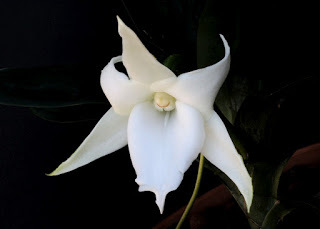We have a King (Angcm. sesquipedale) and we have a Queen (Angcm. magdalenae). And what that produces is Angraecum Lemforde White Beauty. A remarkable hybrid that very much resembles the Queen (although slightly larger).
Two very different Angraecums in size, basic shape and most of all the environments from which they grow. But their offspring pictured above is one of the most sought after Angraecum hybrids to date.
The flower from a sesquipedale can be up to 9 inches across. The magdalenae will produce a flower about 4 inches across. The Beauty will average 5 - 6 inches across; so it's picked up a little size from the sesquipedale. The spur or nectary is about 2 inches longer in the Lemforde White Beauty than it is in the magdalenae; another attribute that it gets from sesquipedale.
The basic shape of the flower is very similar to magdalenae. The sepals are broader closer to the pedicel as are the petals. The lip is not near as long as the sesquipedale but it is much wider resembling the magdalenae. Another prominent feature that has carried over from sesquipedale is the retraction of the petals (they can retract almost 90 degrees).
The environments in which the parents of this hybrid come from are two totally different ends of the spectrum. Angcm. sesquipedale grows on the edge of forests at about 300 feet above sea level on the lower and thicker trunks of trees in a tropical condition. Growing best in nature in bright shade or a bright diffused light. Angcm. magdalenae grows at 5,600 - 6,500 feet above sea level as a semi-terrestrial (also considered a lithophyte plant that establishes itself in several inches of leaf debris and dead vegatation that has gathered between large rocks of the mountain they're found on.
With the sesquipedale growing in a tropical condition, it its well suited for the weather here in South Florida. It will continue to grow and develop 12 months a year. Angcm. magdalenae grows at a much higher altitude and has it's growing season cut back 4 - 5 months when it is drier and much cooler. The plants don't grow as big as the sesquipedale does. Even in the summer months, temperatures do drop and it is the daytime heated rocks that help the magdalenae. What I am getting at is the fact that the sesquipedale originating in tropical conditions allows the Lemforde White Beauty to grow so well here in South Florida. While you may have a every difficult time trying to get an Angcm. magdalenae to bloom here. Our sub tropical climate is no comparison to the mountain regions the Queen grows in.
Angraecum Lemforde White Beauty will grow very similar to Angraecum sesquipedale. However, you can put the plant in a smaller pot (6" shallow) because it will not grow much higher than 10 -14 inches. It will also accept a larger amount of brighter light. My plants here is South Florida get direct sun light until about noon. After that, they get spackled light the remainder of the day. In the cooler north part of the country, the plant will do fantastic in a north facing window. Back off on watering the plant in winter months to about once a week to every 10 days. When the temps start coming back up, move the plant outdoors under an eave overhang and leave it out there until night time temps start hovering around 50 degrees. Angraecum Lemforde White Beauty will bloom and look radiant with it's pristine white flowers anywhere from mid May to late July; that really depends on what part of the country its growing in.
